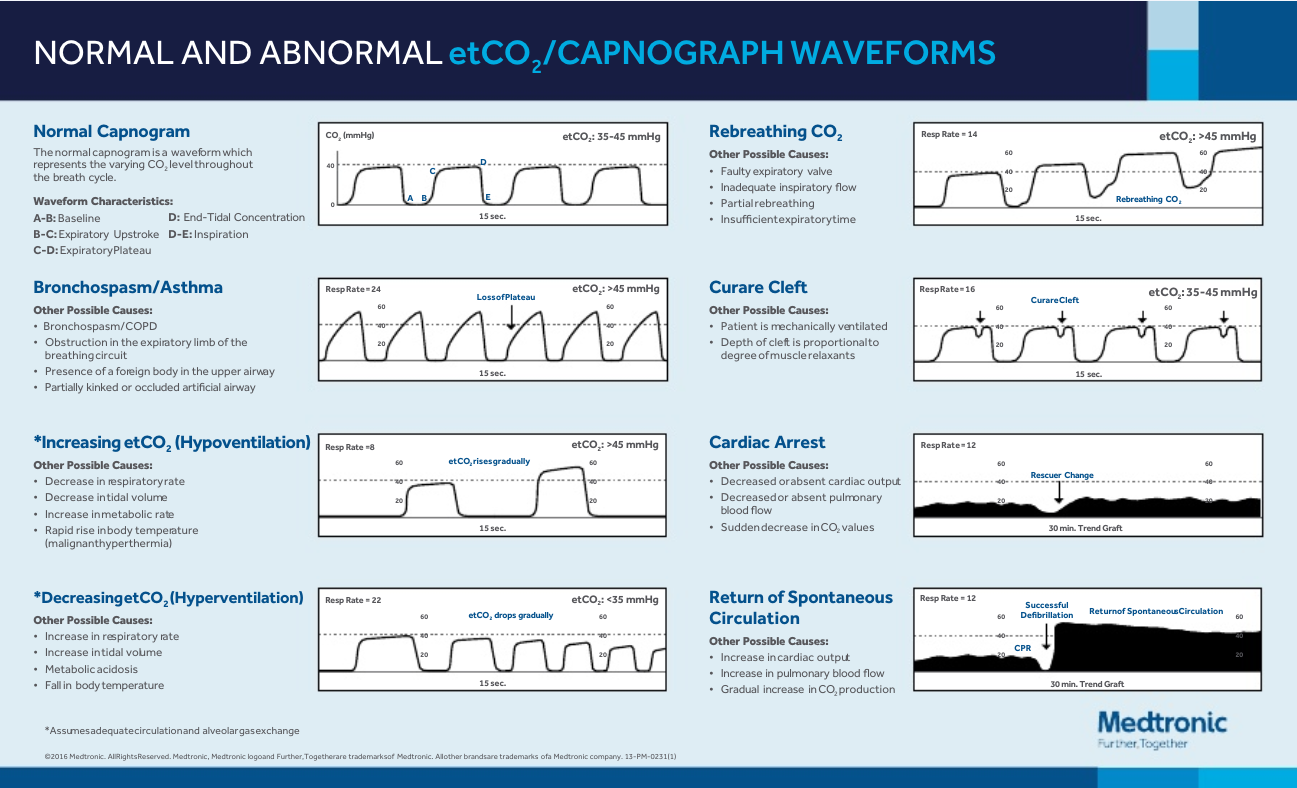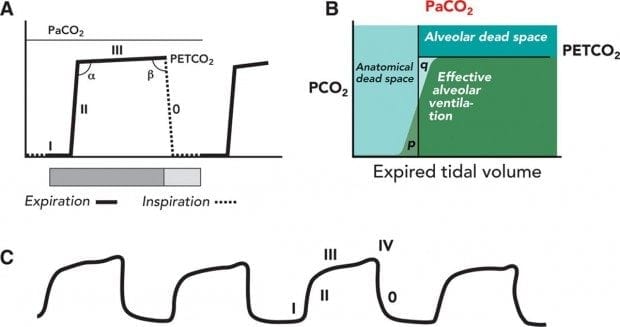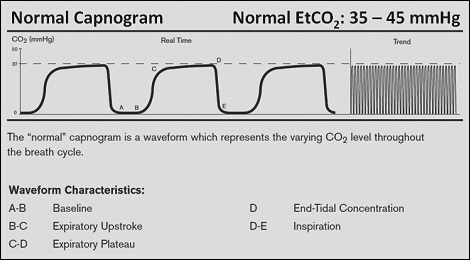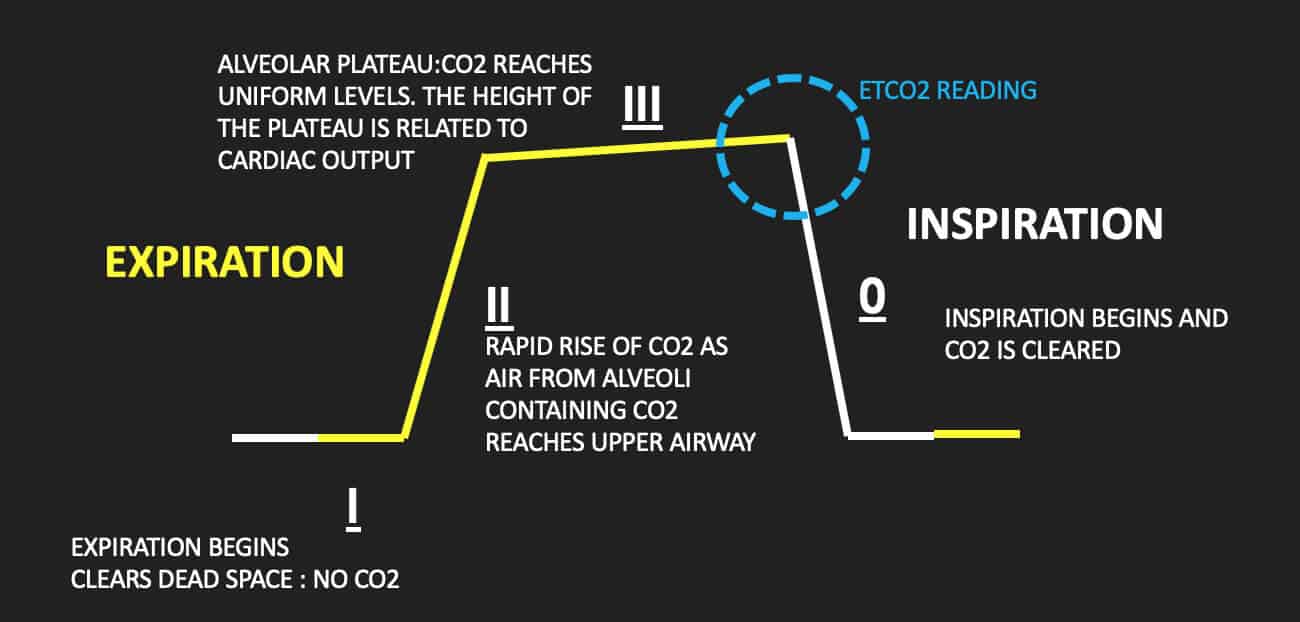end tidal co2 meaning
End-tidal CO2 ETCO2 monitoring is not a new modality in the pediatric emergency department PED and emergency department. End tidal carbon dioxide concentration.

Waveform Capnography In The Intubated Patient Emcrit Project
Most medical sources define hypocapnia as less than 35 mm Hg for partial CO2 pressure in the arterial blood.
. This is a major respiratory symptom. ETCO 2 levels reflect the adequacy with which carbon dioxide CO 2 is carried in the blood back to the lungs and exhaled. Medical Definition of end-tidal.
Capnography refers to the process of measuring the partial pressure of end-tidal CO2 in each expired breath. EtCO 2 reflects cardiac output and pulmonary blood flow as CO 2 is transported by the venous system to the right side of the heart and then pumped to the lungs by the right ventricle as well as the ventilation minute volume Paiva et al 2018. End-tidal CO 2 monitoring has also been useful for breathing retraining as it provides additional information about the progress of a persons breathing normalization.
END TIDAL CO2 Has Many Uses What Is ETCO2. On average during CPR if adequate chest compressions are being delivered a cardiac index of 16-19 Lminm2 can be generated which correlates with ETCO2 pressures of 20mmHg. MONITORING of end-tidal carbon dioxide is one of the most important means of determining the physiologic well-being of anesthetized patients.
On this page we will look at the following two questions. Pulse oximetry assesses oxygenation which is the amount of oxygen that is bound to red blood cells. By that stage anatomical dead space has completely emptied and is no longer contributing to the total expired CO 2 value.
Definition of Low CO2 hypocapnia Hypocapnia hypocapnea also known as hypocarbia is defined as a deficiency of carbon dioxide in the arterial blood. Whilst capnography assesses ventilation which is the movement of air in and out of the lungs. Of or relating to the last portion of expired tidal air End-tidal carbon dioxide monitors are already being used and are recommended to indicate the adequacy of cardiopulmonary resuscitation and the likelihood of a successful resuscitation.
End tidal CO 2 EtCO 2 monitoring is the fastest indicator of ventilatory compromise. End-tidal carbon dioxide is the partial pressure of carbon dioxide EtCO 2 at the end of an exhaled breath. Exhaled carbon dioxide both in terms of its quantity and pattern provides detailed information on the cardiopulmonary system.
The normal values are 5-6 CO2 which is equivalent to 35-45 mmHg. When calculating the gradient the clinician is comparing the carbon dioxide CO 2 sampled from the ABG. Eisenberg and Terry J.
In the awake adult normal cardiac index lies between 25-4 Lminm2 with an ETCO2 of 35-45 mmHg. Sometimes however etCO 2 monitoring is used as a feedback or biofeedback mechanism. The arterial CO2 value for normal breathing at rest is 40.
The gradient is the difference between the arterial carbon dioxide partial pressure PaCO 2 and the etCO 2 partial pressure is a result of the relationship between ventilation and perfusion or rather ventilation-perfusion matching VQ. CO2 is a byproduct of cellular metabolism which gets transported in the blood to the lungs for elimination. 1 ACLS guidelines define high quality chest compressions as.
Mengert The New England Journal of Medicine. Available evidence has established that ETCO 2 measurement can provide an indication of cardiac output and pulmonary blood flow. End-tidal carbon dioxide ETCO 2 is the level of carbon dioxide that is released at the end of an exhaled breath.
However ETCO2 may be underused in the PED setting. Types of End Tidal CO 2 Monitors. It is the standard of care during certain procedures such as intubations and sedations and can be used in variety of clinical situations.
When the measurement is taken at the end of a breath exhaling it is called end tidal CO 2 ETCO 2. Prospective study comparing SpO2 and PETCO2 to calculated arterial oxygen saturation. The capnogram is a direct monitor of the inhaled and exhaled concentration or partial pressure of CO 2 and an indirect monitor of the CO 2 partial pressure in the arterial blood.
Providers measure the value of ETCO2 in each exhaled breath with a very thin tube inserted into the breathing circuit or the patients oxygen mask or nasal prongs. End-tidal capnography or end-tidal CO2 EtCO2 monitoring is a non-invasive technique that measures the partial pressure or maximal concentration of carbon dioxide CO2 at the end of an exhaled breath. To determine whether continuous measurement of arterial oxyhemoglobin saturation SpO2 and end-tidal carbon dioxide PETCO2 can be used to wean patients safely and efficiently from postoperative mechanical ventilation after cardiac surgery.
The amount of CO2 at the end of exhalation or end-tidal CO2 ETCO2 is normally 35-45. Alveolar dead space in particular is what affects the end-tidal CO 2 measurement which is taken at the end of expiration.

Waveform Capnography In The Intubated Patient Emcrit Project

Normal And Abnormal Capnography Waveforms Infographic Capnoacademy Capnoacademy
5 Medical Conditions Where Capnography Can Affect Bls Care Capnoacademy Capnoacademy

Capnography Waveform Interpretation Litfl Ccc Equipment

Basic Capnography Interpretation Nuem Blog

Basic Capnography Interpretation Nuem Blog

How To Read And Interpret End Tidal Capnography Waveforms Emsuk Learning
End Tidal Co2 Monitoring In The Pre Hospital Environment More Than Just Endotracheal Tube Placement Confirmation Journal Of Paramedic Practice
The Normal Capnograph Waveform Deranged Physiology
Riding The Wave Of Capnography Understanding Etco2 Vetbloom Blog

Basic Waveform Capnography As A Continuous Monitoring Tool During Mechanical Ventilation

Waveform Capnography In The Intubated Patient Emcrit Project

Capnogram R Series Defibrillator Zoll Medical Uk
End Tidal Co2 The Drummer Of The Vital Sign Band Pem4

Etco2 Valuable Vital Sign To Assess Perfusion The Airway Jedi

Quantitative Waveform Capnography Acls Medical Training

Emdocs Net Emergency Medicine Educationcapnography In The Ed Emdocs Net Emergency Medicine Education

